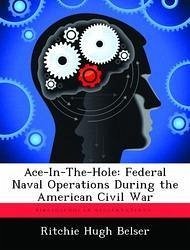Civil War history is usually concerned with the opposing field armies, their leaders, and their victories. Less has been written and discussed about the two navies roles during the War Between the States. The Federal Navy was heavily tasked by and critically important to the Lincoln administrations' war strategy. That strategy, General Winfield Scott's "Anaconda Plan," was energetically executed by the Union Navy and proved to be a significant factor for ultimate Union victory. The Confederate Navy attempted to counter Union strategy by developing two new types of ships (ironclads and blockade runners), as well as producing two new underwater weapons (submarines and mines). Though the new Confederate technologies were no match for the numerical advantage enjoyed by the Union Navy, their role in the Civil War was noteworthy, and they will be seen again in two upcoming world wars. The federal maritime strategy of blockading the southern coastline and seizing control of the Mississippi caused severe military, psychological and economic challenges for the South. Regarding combined Army-Navy operations employed by the North, Vicksburg proved to be a superb example of federal "joint operations strategy . The Union Navy, which became Mr. Lincoln's "ace-in-the hole," was instrumental in many Union Army victories. It was the superior Civil War naval force and force multiplier which Mr. Lincoln and his strategists came to depend upon and which significantly contributed to preserving the Union. This work has been selected by scholars as being culturally important, and is part of the knowledge base of civilization as we know it. This work was reproduced from the original artifact, and remains as true to the original work as possible. Therefore, you will see the original copyright references, library stamps (as most of these works have been housed in our most important libraries around the world), and other notations in the work. This work is in the public domain in the United States of America, and possibly other nations. Within the United States, you may freely copy and distribute this work, as no entity (individual or corporate) has a copyright on the body of the work. As a reproduction of a historical artifact, this work may contain missing or blurred pages, poor pictures, errant marks, etc. Scholars believe, and we concur, that this work is important enough to be preserved, reproduced, and made generally available to the public. We appreciate your support of the preservation process, and thank you for being an important part of keeping this knowledge alive and relevant.
Bitte wählen Sie Ihr Anliegen aus.
Rechnungen
Retourenschein anfordern
Bestellstatus
Storno








